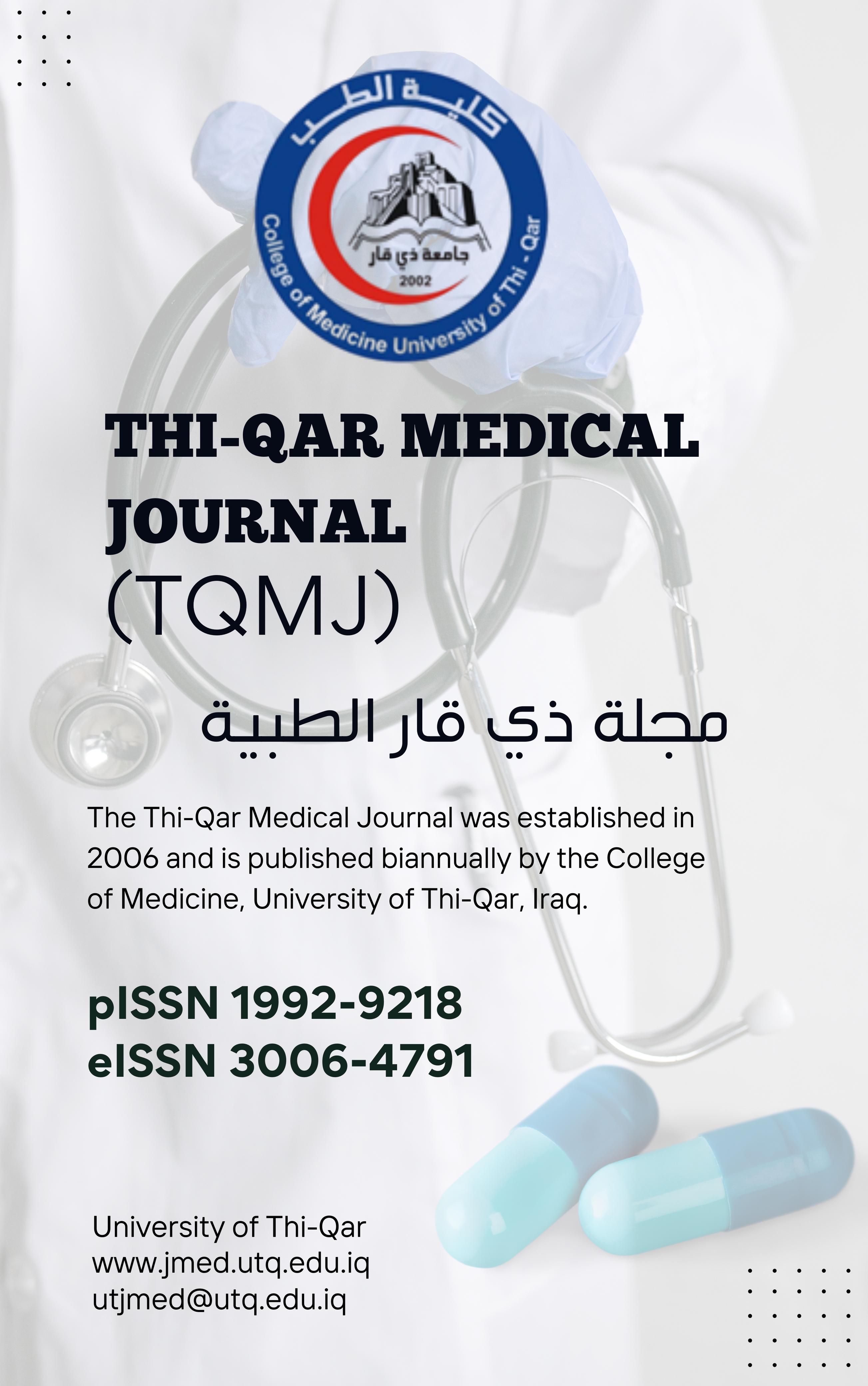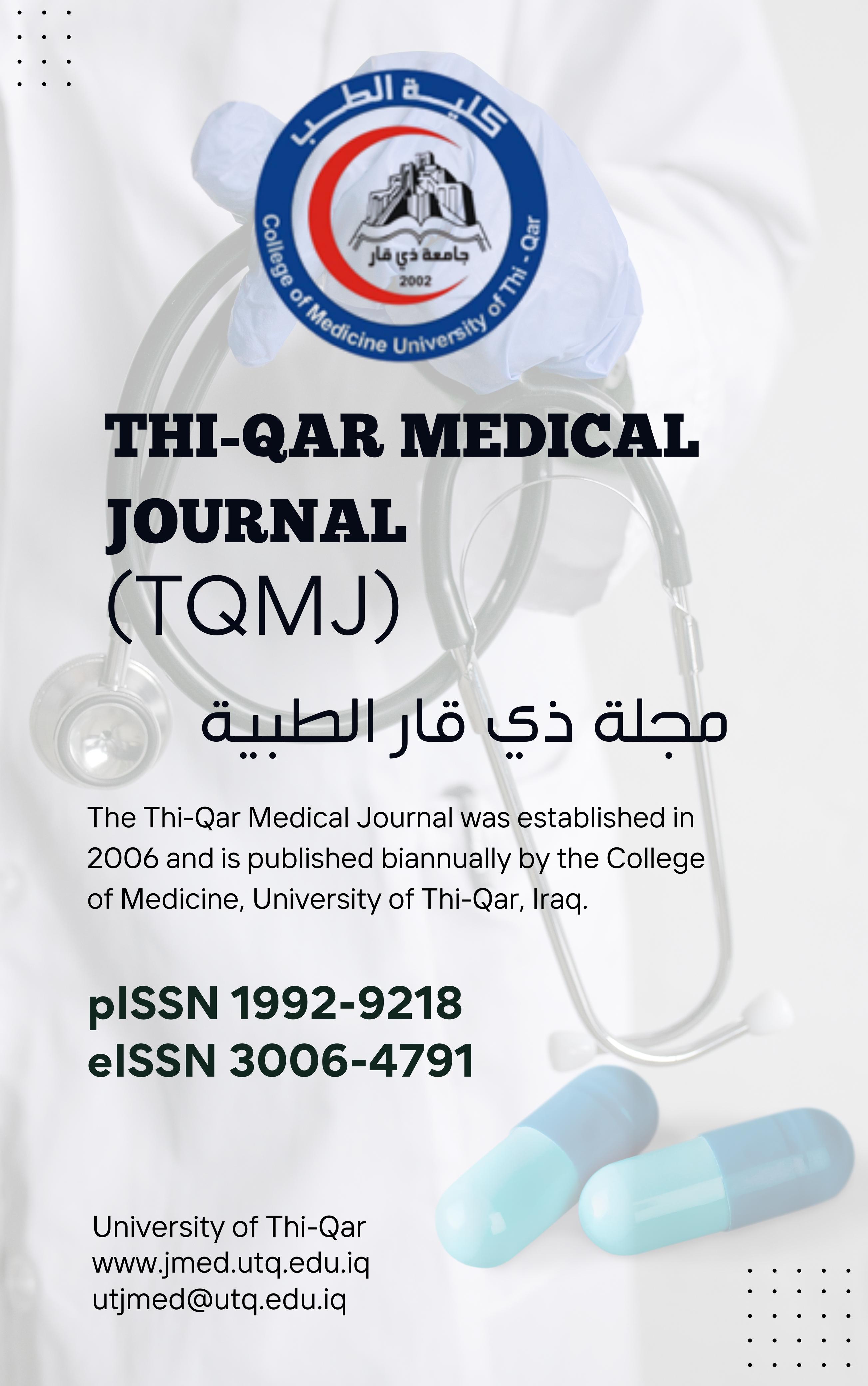Eco-Friendly Biosynthesis of Silver Nanoparticles Using Fusarium Proliferatum: A Promising Agent for Bioremediation and Antimicrobial Applications
DOI:
https://doi.org/10.32792/jmed.2025.29.13Keywords:
Metal nanoparticles, silver nanoparticles, Fusarium proliferatum, Bioremediation, Multidrug-resistant, microorganismsAbstract
The metallic nanoparticles production has attracted much attention latelybecause of their growing use in the medicinal sciences and engineering. They
may be modified with specific functional groups to interact with medications
and antibodies in an efficient manner, these nanoparticles are particularly
interesting because of their special nanotechnology capabilities. Mostly between
10 and 100 nm in size, among other traits metallic nanoparticles have surface
plasmon resonance and special optical qualities.
The subject of this study is Fusarium proliferatum, That was isolated from a soil
sample, in order to find out its potential as a biocatalyst for the manufacture of
silver nanoparticles (AgNPs) and its potential to withstand multidrug-resistant
(MDR) bacteria. The evaluation was The fungus's ability to endure different
heavy metals. From the findings, Fusarium proliferatum shown resistance to a
several heavy metals at variant concentrations, such as copper (Cu) , nickel (Ni),
zinc (Zn), silver (Ag), and mercury (Hg). Range of tolerance was shown
depending on the metal, the colony formation of Fusarium proliferatum showed
with certain strains being extremely resistant, moderately tolerant, or
susceptible.
By removing heavy metals from contaminated soils, this strain of Fusarium
proliferatum has the ability to be used in bioremediation. Also, encouraging
antibacterial qualities was shown by using the creation of Ag nanoparticles, That
made them useful against microbes which are resistant to many drugs.
References
Nasrollahzadeh M, Sajadi SM, Sajjadi M, Issaabadi Z. An introduction to nanotechnology. In: Interface
Science and Technology. Vol 28. Elsevier; 2019:1-27. doi:10.1016/B978-0-12-813586-0.00001-8
Khan Y, Sadia H, Ali Shah SZ, Khan MN, Shah AA, Ullah N, et al. Classification, synthetic, and
characterization approaches to nanoparticles, and their applications in various fields of nanotechnology: a
review. Catalysts. 2022;12(11):1386. doi:10.3390/catal12111386
and Pandit C, Roy A, Ghotekar S, Khusro A, Islam MN, Emran TB, et al. Biological agents for synthesis of
nanoparticles their applications. doi:10.1016/j.jksus.2021.101869 J King Saud Univ Sci. 2022;34(3):101869.
Abdellatif AA, Mohammed HA, Khan RA, Singh V, Bouazzaoui A, Yusuf M, et al. Nano-scale delivery: A
comprehensive review of nano-structured devices, preparative techniques, site-specificity designs,
biomedical applications, commercial products, and references to safety, cellular uptake, and organ toxicity.
Nanotechnol Rev. 2021;10(1):1493-1559. doi:10.1515/ntrev-2021-0116
Altammar KA. A review on nanoparticles: characteristics, synthesis, applications, and challenges. Front
Microbiol. 2023;14:1155622. doi:10.3389/fmicb.2023.1155622
Hulkoti NI, Taranath TC. Biosynthesis of nanoparticles using microbes—a review. Colloids Surf B
Biointerfaces. 2014;121:474-483. doi:10.1016/j.colsurfb.2014.05.027
Samuel MS, Ravikumar M, John JA, Selvarajan E, Patel H, Chander PS, et al. A review on green synthesis
of nanoparticles and their diverse biomedical and environmental applications. Catalysts. 2022;12(5):459.
doi:10.3390/catal12050459
Werkneh AA, Rene ER, Lens PNL, Kumar V, Dasgupta N, Ranjan S. Application of nanomaterials in
food, cosmetics, and other related process industries. In: Nanotoxicology: Toxicity Evaluation, Risk
Assessment and Management. Elsevier; 2018:63-80. doi:10.1016/B978-0-12-811993-9.00004-0 117
Sharma VK, Sayes CM, Guo B, Pillai S, Parsons JG, Wang C, et al. Interactions between silver
nanoparticles and other metal nanoparticles under environmentally relevant conditions: a review. Sci Total
Environ. 2019;653:1042-1051. doi:10.1016/j.scitotenv.2018.10.430
Roychoudhury A. Yeast-mediated green synthesis of nanoparticles for biological applications. Indian J
Pharm Biol Res. 2020;8(3):26–31. doi:10.30750/ijpbr.8.3.4
Ovais M, Khalil AT, Ayaz M, Ahmad I, Nethi SK, Mukherjee S. Biosynthesis of metal nanoparticles via
microbial enzymes: a mechanistic approach. Int J Mol Sci. 2018;19(12):4100. doi:10.3390/ijms19124100
Amin I, Nazir R, Rather MA. Nano-bioremediation: an innovative approach for remedying heavy metals
using fungi. J Bioremediat Biodegrad. 2021;12(487):2. doi:10.35248/2155-6199.21.12.487
Goutam J, Sharma J, Singh R, Sharma D. Fungal-mediated bioremediation of heavy metal–polluted
environment. In: Microbial Rejuvenation of Polluted Environment. Vol 2. Springer; 2021:51-76.
doi:10.1007/978-981-15-9962-1_3
Gharieb MM, Khatab MS, Soliman AM, Taha MS. Biosynthesis of silver nanoparticles by endophytic
fungus Fusarium proliferatum isolated from Allium sativum and its antimicrobial effect against multidrug
resistant bacteria. Microbes Infect Dis. 2025;6(1):355-368. doi:10.21608/mid.2025.349781
Bamal D, Singh A, Chaudhary G, Kumar M, Singh M, Rani N, et al. Silver nanoparticles biosynthesis,
characterization, antimicrobial activities, applications, cytotoxicity and safety issues: An updated review.
Nanomaterials. 2021;11(8):2086. doi:10.3390/nano11082086
Esmatabadi MD, Bozorgmehr A, Hajjari SN, Sombolestani AS, Malekshahi ZV, Sadeghizadeh M. Review
of new insights into antimicrobial agents. Cell Mol Biol (Noisy-le-grand). 2017;63(2):40-48.
doi:10.14715/cmb/2017.63.2.8
Guilger-Casagrande M, Lima R. Synthesis of silver nanoparticles mediated by fungi: a review. Front
Bioeng Biotechnol. 2019; 7:287. doi:10.3389/fbioe.2019.00287
Šebesta M, Vojtková H, Cyprichová V, Ingle AP, Urík M, Kolenčík M. Mycosynthesis of metal-containing
nanoparticles—fungal metal resistance and mechanisms of synthesis. Int J Mol Sci. 2022;23(22):14084.
doi:10.3390/ijms232214084
Meena M, Swapnil P, Yadav G, Sonigra P. Role of fungi in bio-production of nanomaterials at megascale.
In: Fungi Bio-Prospects in Sustainable Agriculture, Environment and Nano-Technology. Springer;
:453-474. doi:10.1007/978-981-15-8578-5_20
Rai M, Golińska P. Mycosynthesis of Nanomaterials. London, UK: Taylor & Francis; 2023.
doi:10.1201/9781003200765
Downloads
Published
Issue
Section
License
Copyright (c) 2025 Poshya Omer Hama, Brwa Zahid Mohammed

This work is licensed under a Creative Commons Attribution 4.0 International License.





